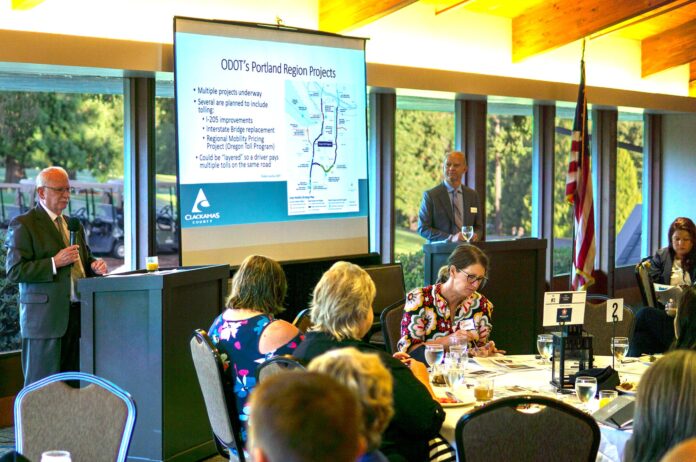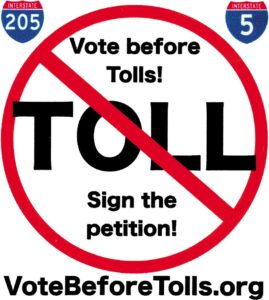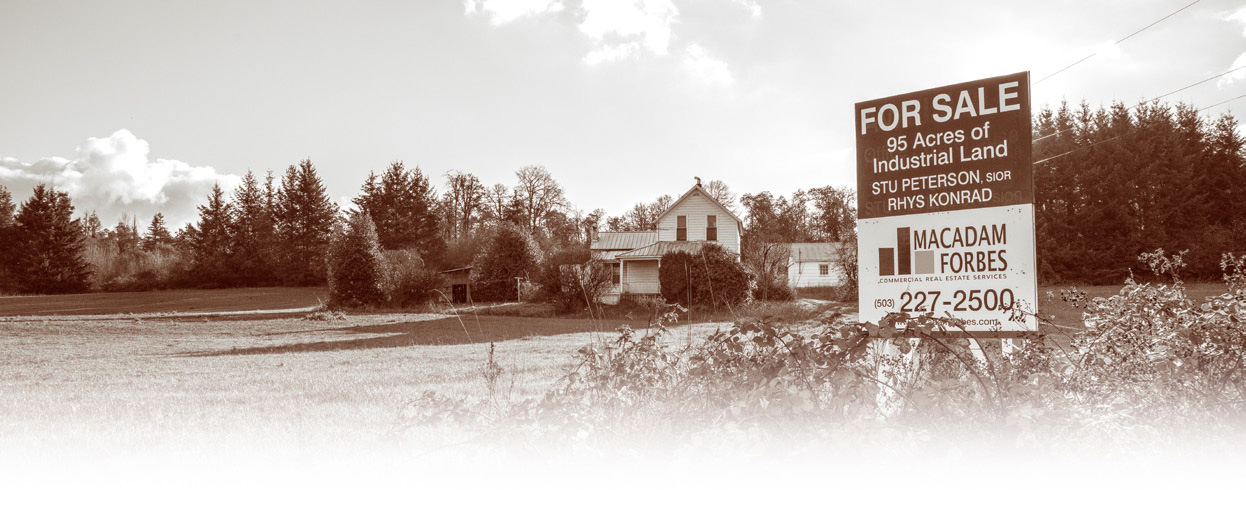
The cascade of negatives that could flow from tolling parts of Interstate 205 should be high on the community’s radar, said two area county commissioners who questioned the Oregon Department of Transportation’s proposal at a breakfast earlier this month.
“People will be cutting through our neighborhoods all the time to avoid tolls,” Clackamas County Commissioner Paul Savas warned, adding that the ensuing traffic snarls will be bad for both the environment and local businesses.
Savas and Washington County Commissioner Roy Rogers were the keynote speakers at a Sept. 8, Key Leaders Series breakfast at Tualatin Country Club, hosted by the Tualatin Chamber of Commerce.
The morning event focused on ODOT’s plan to instate around-the-clock electronic tolling on portions of the interstate, including the I-205 Tualatin Bridge, which crosses the Tualatin River near Stafford Road, and another bridge, the Abernathy, spanning the Willamette River in Oregon City.
According to ODOT, the coming tolls, which were legislated by HB-2017, seek to ease peak drive-time traffic, reducing highway congestion and emissions. The Agency has yet to study the environmental and traffic flow impacts of toll-induced diversion to smaller, local routes.
Planning for the project began in 2021, following the passing of legislation in 2017 that mandated environmental and congestion tolls on stretches of I-205 and I-5. Toll collections are projected to start in 2024, following the completion of regional planning later this year and environmental and federal reviews slated for 2023 and 24.
2021 legislation expanded the study area from the I-5 Rose Quarter and I-205 around West Linn to the entire Portland metro area from the Boone Bridge on I-5 up to the Columbia River.
“One of the takeaways today is: how do we get our voices heard?” Savas told the crowd of about 120.
Rogers encouraged business leaders to apply for a spot on the committee, and to back a proposed amendment to the state constitution that would require a vote to enact tolling measures.
“I’m here to tell you beyond a shadow of a doubt; unless you grow, raise everything you eat on your particular plot of land, unless you manufacture everything you use – that’s your cars, your computers, your furniture – unless you do those things, tolling will impact you,” Rogers said. “So, you need to be aware. You are not without impact.”
Rogers, who has represented Tigard, Tualatin, Sherwood, and King City since 1985 and served as Tualatin Mayor from 1978 – 1985, warned that tolling would increase shipping costs, and those increases would trickle down through businesses to consumers, inflating prices at every junction.
“Is it going to increase inflation? Absolutely,” said Rogers. “There’s no way you as businesspeople are going to take a fee and not pass it on.”
The Oregon Transportation Commission will use public feedback, cost of living, inflation, congestion relief goals, and revenue needs to determine rates, which may include an income-based sliding scale.
Though the 2017 mandate was drafted as a temporary, fixed-rate toll to generate funds for targeted projects, the current proposal includes variable “congestion pricing” meant to alter driver behavior by upping the rates during peak drive times.
“What’s the bottom line on congestion pricing?” Rogers asked. “What does it mean to all of you? It’s all lanes, all hours, all days.”
And, the commissioners warned, it’s not just costs that will spill out into the community.
If the intent is to coax drivers from their cars by making the commute more expensive, the plan is missing a crucial element: public transportation. Without public transportation to carry commuters, there’s no prying drivers out from behind the wheel.
“Why we think it’s unfair, is there are no alternatives,” Savas said
Instead, they’ll steer off the pricey interstate into what he calls the “third lane,” backing up traffic on already slow-moving state routes and neighborhood streets, a pattern he’s seen play out in areas of Clackamas where diversion has been happening for more than a decade.
“It’s dangerous,” he said, describing afternoon traffic jams that last more than two hours on a neighborhood street in West Linn.
Though ODOT pledges to earmark a portion of the revenues for repairs and improvement to impacted routes, only some affected cities are slated to receive the “diversion money.”
According to Rogers, King City and Sherwood, and most of Tigard and Tualatin won’t see any of it.
“It’s an unfair tolling,” Savas said, adding he wouldn’t mind paying into a system that also provides a return on the fee.
Vote Before Tolls

A grassroots organization called ‘Vote Before Tolls Committee’ has formed to introduce a constitutional amendment that will require a public vote before highway tolls go into effect. If successful, the amendment will be placed on the 2024 ballot and, if passed, be retroactive to 2018. For more information, visit votebeforetolls.org.


















